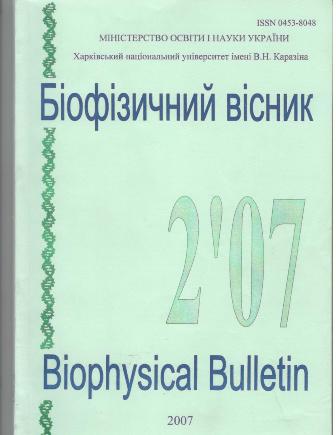До розуміння фазової діаграми механічного розкриття подвійної спіралі ДНК
Анотація
Дано інтерпретацію фазовій діаграмі (температура-сила) механічного плавлення подвійної спіралі в температурному інтервалі від 15 до 50 °С. Змодельовано процес розкриття подвійної спіралі з урахуванням імовірної траєкторії механічного розділення тяжів під дією зовнішньої сили, формування метастабільних станів пар основ в ДНК при високих температурах та можливості переходу макромолекули в конденсований стан при низьких температурах. Показано, що відкриття подвійної спіралі в різних температурних інтервалах можна розглядати як фазовий перехід першого роду індукований зовнішньою силою. Одержано вираз для критичної сили розкриття подвійної спіралі та розраховано залежність сили від температури. Продемонстровано згоду теорії та експерименту для температурного інтервалу 24-35 °С. Запропоновано механізми появи плато на фазовій діаграмі залежності сили від температури для інтервалів вище 35 °С та нижче 24 °С.
Завантаження
Посилання
M. Helmer, Nature 401, 225-226 (1999).
C. Bustamante, Z. Bryant, S. Smith, Nature 421, 423-427 (2003).
B.Esscvaz-Roulet, U.Bockelmann, F.HesIot, PNAS 94, 11935-11940 (1997).
U. Bockelmann, Ph. Thomen, B. Essevaz-Roulet, V. Visnoff, F.
Heslot, Biophys. J. 82, 1537 (2002).
C. Danilowicz, V.W. Coljee, C. Bouzigues, D.K. Lubensky, D.R.
Nelson, M. Prentiss, PNAS 100. 1694-1699 (2003).
C. Danilowicz, Y. Kafri, R.S. Conroy, V.W. Coljee, J. Weeks, M.
Prentiss, Phys. Rev. Lett. 93. 078101 (2004).
N.K. Voulgarakis. A. Redondo, A.R. Bishop, K.0. Rasmussen, Phys.
Rev. Lett. 96, 248101 (2006).
C.R. Cantor, PR. Schimmel, Biophysical Chemistry, W.H. Freeman and
Co.. p. Ill, ch. 22 (1980).
W. Saenger, Principles of Nucleic Acid Structure, Springer-Verlag,
ch. 6 (1984).
S.N. Volkov, Inter. Joum. Quant. Chem. 16, 119-132 (1979).
Yu.L. Lyubchenko, Yu.A. Kalambet, V.I. Lyamichev, A.S. Borovik,
Nucleic Acids Research 10, 1867-1876 (1982).
M.D. Frank-Kamenetskii, A.V. Vologodskii. Nature 269. 729-730 (1977).
R.B. Genis, C.R. Cantor, J. Mot. Biol. 69. 381 (1973).
A.K. Schyolkina, L.E. Minchenkova, V.I. Ivanov, Mol. Biol.
(Moscow) 11, 466 (1977).
S.S. Chan, K.J. Breslauer. Biochemistry 29,6161-6171 (1990).
G. Altan-Bonnet, A. Libchaber, O. Krichevsky, Phys. Rev. Lett.
, 138101 (2003).
V.A. Bloomfield, Biopolymers 44, 269-282 (1997).
R. Lavery, Adv. Comput. Biol. 1,69-145 (1994).
S.N. Volkov, Biophysical Bulletin 2(7), 7 15 (2000).
S.A. Lee, S.M. Lindsay, J.W. Powell, T. Weidlich, N.J. Tao. G.D.
Lewen, A. Rupprecht. Biopolymers 26, 1637-1665(1987).
M.D. Frank-Kamenetskii, Yu.S. Lazurkin, Ann. Rev. Bioph. Bioeng.
, 127-150 (1974).
R.D. Blake, S.G. Delcourt, Nucleic Acids Res. 26, 3323-3329 (1998).
J. Santalucia, Jr., H.T. Allawi, P.A. Sencviratne, Biochemistry
, 3555-3562 (1996).
E.S. Kryachko, S.N. Volkov, Inter. J. Quant. Chem. 82, 193-204 (2001).
I-:. Giudice, P. Varnai, R. Lavery, Nucleic Acids Research 31.
-1443 (2003).
S.N. Volkov, A.M. Kosevich,7. Biomolec. Struct. Dynamics*,
-1083 (1991).
D.M.F. van Aalten, D.A. Erlanson, G.I. Verdine. 1. Joshua-Tor,
PNAS96, 11809-11814 (1999).
C.B. Post, B.H. Zimm, Biopolymers, 18, 1487-1501 (1979).
A.Yu. Grosberg, A.R. Khokhlov, Statistical Physics of
Macromolecules. Nauka Publishers (1989).
A.V. Yakubovich, LA. Solov'yov, A.V. Solov'yov, W. Grciner, Eur.
Phys. J. D40, 363-367 (2006).
S. Kumar, I. Jensen, J.L. Jacobsen, A.J. Guttmann, Phys. Rev.
Lett. 90, 128101(2007).
Автори, які публікуються у цьому журналі, погоджуються з наступними умовами:
- Автори залишають за собою право на авторство своєї роботи та передають журналу право першої публікації цієї роботи на умовах ліцензії Creative Commons Attribution License, котра дозволяє іншим особам вільно розповсюджувати опубліковану роботу з обов'язковим посиланням на авторів оригінальної роботи та першу публікацію роботи у цьому журналі.
- Автори мають право укладати самостійні додаткові угоди щодо неексклюзивного розповсюдження роботи у тому вигляді, в якому вона була опублікована цим журналом (наприклад, розміщувати роботу в електронному сховищі установи або публікувати у складі монографії), за умови збереження посилання на першу публікацію роботи у цьому журналі.
- Політика журналу дозволяє і заохочує розміщення авторами в мережі Інтернет (наприклад, у сховищах установ або на особистих веб-сайтах) рукопису роботи, як до подання цього рукопису до редакції, так і під час його редакційного опрацювання, оскільки це сприяє виникненню продуктивної наукової дискусії та позитивно позначається на оперативності та динаміці цитування опублікованої роботи (див. The Effect of Open Access).





